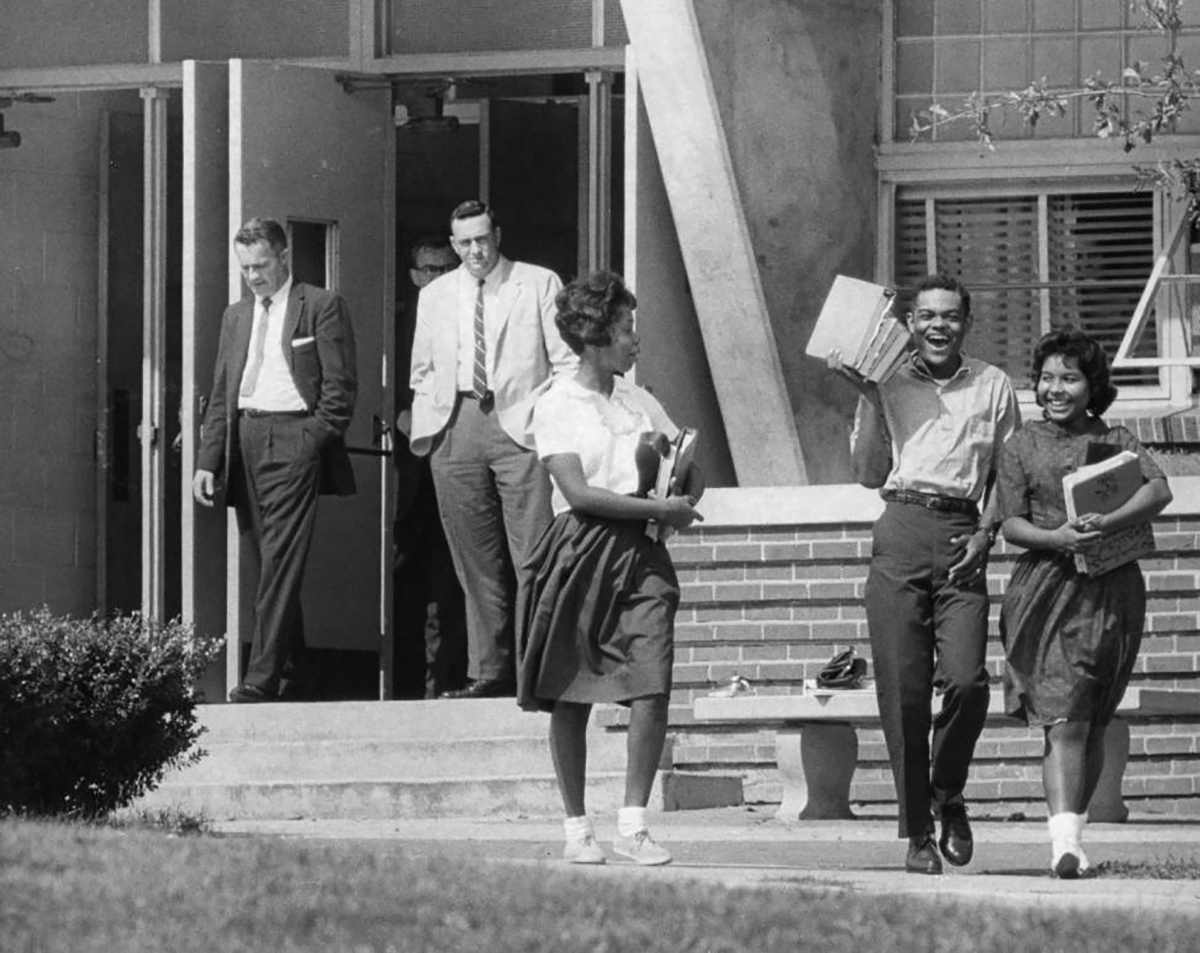The Fall Of School Desegregation Orders: A Look At The Future Of Integration

Table of Contents
The Erosion of Desegregation Orders
The progress made in achieving school desegregation following Brown v. Board of Education has significantly eroded over time, due to a confluence of legal decisions, funding disparities, and persistent residential segregation.
The Supreme Court's Shifting Stance
The Supreme Court's interpretation of school desegregation has shifted dramatically over the years. Key rulings have significantly weakened or effectively overturned previous desegregation orders.
- Milliken v. Bradley (1974): This case limited the scope of desegregation remedies, ruling that inter-district busing was not required unless there was evidence of intentional segregation across district lines. This significantly hampered efforts to integrate schools in metropolitan areas where segregation was often a product of both intra- and inter-district housing patterns.
- Parents Involved in Community Schools v. Seattle School Dist. No. 1 (2007): This decision struck down race-conscious student assignment plans in Seattle and Louisville, Kentucky, arguing that these plans violated the Equal Protection Clause of the Fourteenth Amendment. The Court ruled that diversity could not be a compelling state interest justifying race-based assignments, further limiting the tools available to achieve integration.
These decisions, based on legal arguments centered on the interpretation of the Fourteenth Amendment and the limitations of judicially mandated remedies, have had a profound impact on school districts across the nation, leaving many with limited legal recourse to address persistent racial segregation.
Funding Disparities and Resource Allocation
Unequal funding between schools significantly exacerbates school segregation. Predominantly minority schools often receive less funding than their majority-white counterparts, leading to disparities in resources, teacher quality, and educational opportunities.
- Property Taxes: The reliance on local property taxes to fund schools often perpetuates segregation. Wealthier, predominantly white neighborhoods tend to have higher property values, resulting in more funding for their schools. This creates a vicious cycle, where better-funded schools attract families with more resources, further reinforcing segregation.
- Impact on Student Achievement: The funding gap directly impacts student achievement, with students in under-resourced schools consistently scoring lower on standardized tests and having lower graduation rates. This disparity creates a significant barrier to social mobility and perpetuates inequality across generations.
Statistics reveal a stark reality: schools serving predominantly minority students often have fewer books, outdated technology, larger class sizes, and less experienced teachers compared to schools in wealthier, whiter neighborhoods.
Residential Segregation and Its Impact
Residential segregation remains a major obstacle to achieving meaningful school desegregation. Racially isolated neighborhoods often translate into racially isolated schools.
- Housing Policies: Historical and ongoing housing policies, such as redlining and discriminatory lending practices, have created and maintained racially segregated neighborhoods. These policies have contributed to the concentration of poverty and minority populations in certain areas, making integrated schooling exceedingly difficult.
- Challenges of Addressing Residential Segregation: Tackling residential segregation requires addressing deeply ingrained societal biases and systemic inequalities in housing markets. This is a complex challenge requiring long-term, multifaceted solutions.
The close correlation between residential and school segregation highlights the importance of considering both when developing strategies for integration.
The Consequences of School Segregation
The consequences of school segregation extend far beyond the immediate school environment, impacting students' academic achievement, social and emotional development, and long-term life opportunities.
Academic Achievement Gaps
The achievement gap between students in segregated schools is well-documented. Students in predominantly minority schools consistently score lower on standardized tests and have lower graduation rates compared to their peers in predominantly white schools.
- Long-Term Economic Implications: This achievement gap translates into significant long-term economic disadvantages, limiting opportunities for higher education, career advancement, and overall economic mobility.
- Societal Impact: The perpetuation of the achievement gap contributes to broader societal inequalities, reinforcing existing disparities in wealth, health, and social status.
The academic consequences of segregation are severe and far-reaching, creating a cycle of disadvantage that is difficult to break.
Social and Emotional Development
Segregated schooling also significantly impacts students' social and emotional development. Lack of exposure to diverse perspectives and experiences can hinder students' ability to navigate a diverse society.
- Benefits of Diverse Learning Environments: Research consistently shows that diverse learning environments foster empathy, understanding, and collaboration among students from different backgrounds. These benefits extend beyond academics, enriching students' social and emotional development.
- Challenges of Segregated Environments: In contrast, segregated environments can foster stereotypes, prejudice, and limited social skills, impacting students' self-esteem and social competence.
Creating inclusive and diverse learning environments is crucial for fostering positive social and emotional development in all students.
Pathways to Achieving Meaningful Integration
Overcoming the persistent challenge of school segregation requires a multi-pronged approach that combines policy reforms, legal strategies, and community engagement.
Policy Reforms and Legal Strategies
Challenging existing practices that perpetuate segregation requires innovative legal strategies and comprehensive policy reforms.
- Legal Challenges: Legal challenges to discriminatory school funding mechanisms and housing policies could play a crucial role in dismantling systemic inequalities that contribute to segregation.
- Policy Recommendations: Policies like magnet schools, carefully designed school choice programs with equity considerations, and targeted investments in under-resourced schools can actively promote integration. These programs must be implemented with equity at their core, ensuring equitable access for all students.
Innovative approaches are needed to create a more just and equitable school system.
Community Engagement and Collaborative Efforts
Community involvement is paramount in achieving successful school integration. Building bridges between different racial and ethnic groups requires collaborative efforts at the local level.
- Strategies for Community Engagement: Town halls, community dialogues, and collaborative planning processes involving parents, educators, and community leaders can foster understanding and build consensus around integration initiatives.
- Overcoming Resistance to Change: Addressing resistance to change requires open communication, transparency, and addressing concerns from all stakeholders.
Sustainable school desegregation requires a collaborative effort from all segments of society.
Conclusion
The decline of school desegregation orders presents a critical challenge to achieving educational equity and social justice. While legal battles continue, meaningful progress requires a multi-pronged approach that addresses funding disparities, residential segregation, and promotes community collaboration. Moving forward, a renewed commitment to addressing school desegregation through comprehensive policy reforms and community engagement is essential to building a truly integrated and equitable education system for all children. Let's work together to ensure a future where school desegregation is not just a legal aspiration but a lived reality. We must actively work towards dismantling the systemic barriers to equitable school access and fostering meaningful school integration for all students.

Featured Posts
-
 Solidarnosc I Republika Porownanie Retoryczne Wg Sakiewicza
May 02, 2025
Solidarnosc I Republika Porownanie Retoryczne Wg Sakiewicza
May 02, 2025 -
 Should You Buy Xrp Now A 400 Price Increase In 3 Months Analyzed
May 02, 2025
Should You Buy Xrp Now A 400 Price Increase In 3 Months Analyzed
May 02, 2025 -
 Tulsa Homeless Crisis Rising Numbers And The Tulsa Day Centers Response
May 02, 2025
Tulsa Homeless Crisis Rising Numbers And The Tulsa Day Centers Response
May 02, 2025 -
 Japans Central Bank Lowers Economic Growth Projection Due To Trade Tensions
May 02, 2025
Japans Central Bank Lowers Economic Growth Projection Due To Trade Tensions
May 02, 2025 -
 Analyzing Voter Turnout In Florida And Wisconsin Understanding The Political Landscape
May 02, 2025
Analyzing Voter Turnout In Florida And Wisconsin Understanding The Political Landscape
May 02, 2025
Latest Posts
-
 Can Reform Uk Deliver For Farmers A Critical Analysis
May 03, 2025
Can Reform Uk Deliver For Farmers A Critical Analysis
May 03, 2025 -
 Wrqt Syasat Aqtsadyt Mn Amant Alastthmar Baljbht Alwtnyt
May 03, 2025
Wrqt Syasat Aqtsadyt Mn Amant Alastthmar Baljbht Alwtnyt
May 03, 2025 -
 Amant Alastthmar Baljbht Alwtnyt Wrqt Syasat Aqtsadyt Jdydt
May 03, 2025
Amant Alastthmar Baljbht Alwtnyt Wrqt Syasat Aqtsadyt Jdydt
May 03, 2025 -
 Ampliacion De Flota Vehicular En El Sistema Penitenciario 7 Unidades
May 03, 2025
Ampliacion De Flota Vehicular En El Sistema Penitenciario 7 Unidades
May 03, 2025 -
 7 Nuevos Vehiculos Para Mejorar La Seguridad Penitenciaria
May 03, 2025
7 Nuevos Vehiculos Para Mejorar La Seguridad Penitenciaria
May 03, 2025
